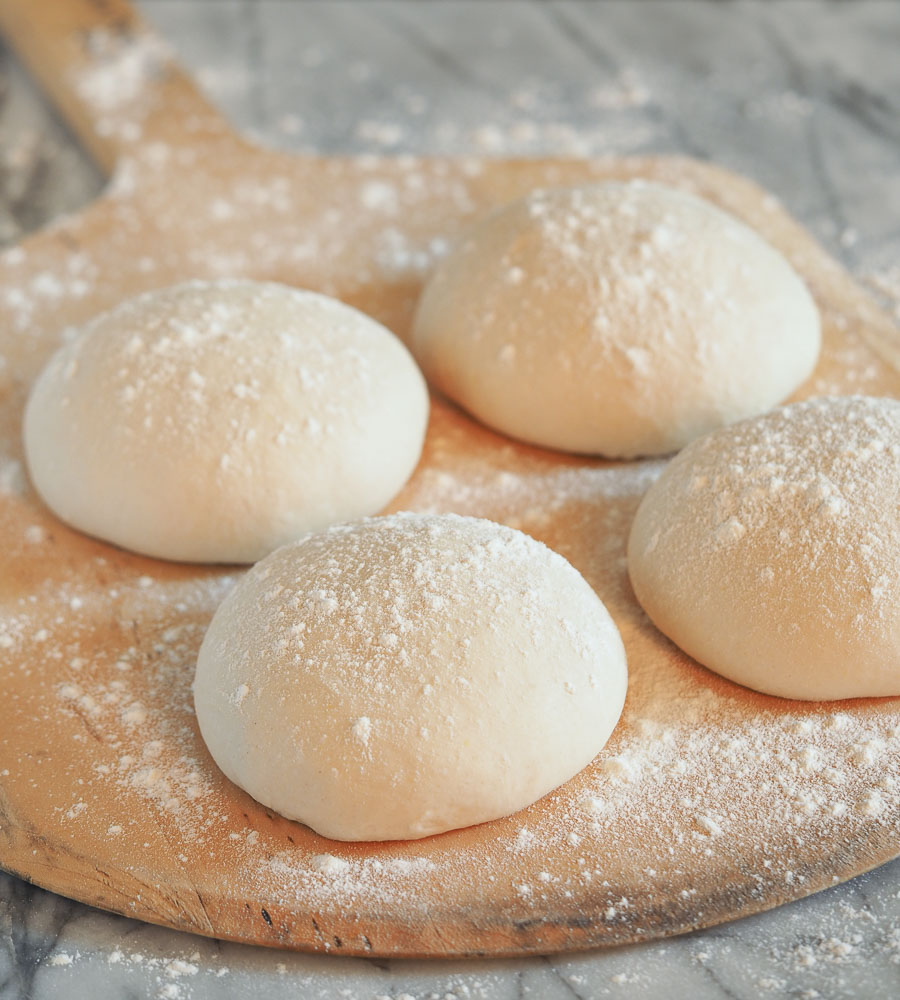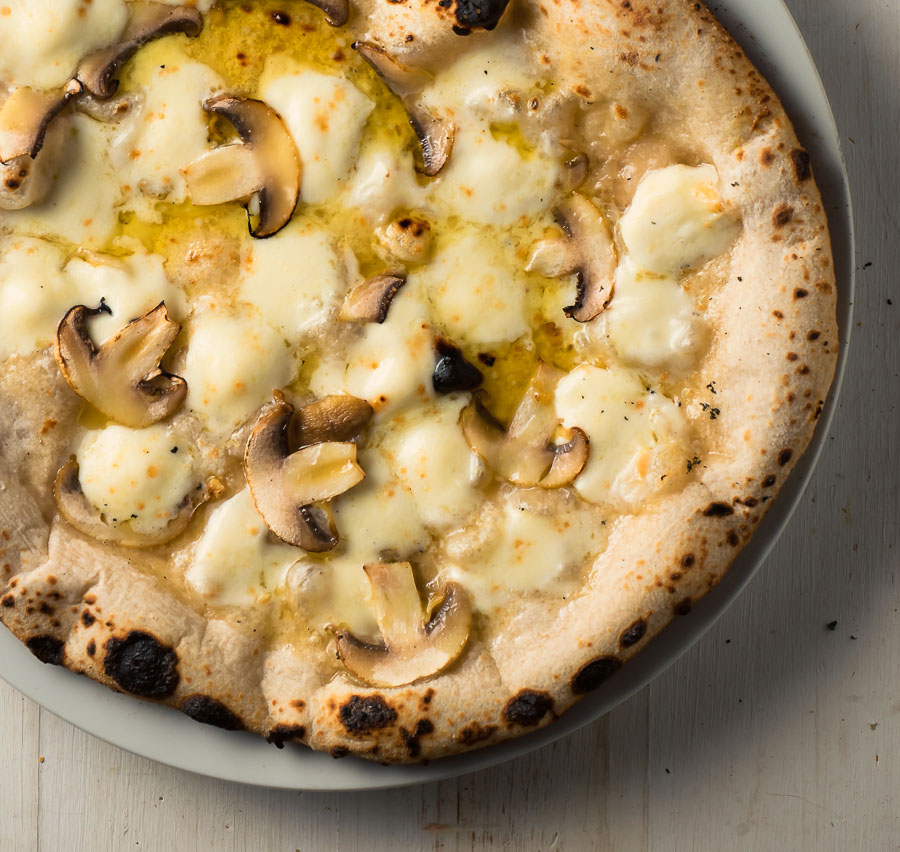Neapolitan pizza is a magical thing. The crust has a tang. Real flavour. Not that drab, everybody eats around it stuff.
And it starts with the dough. This isn’t your everyday pizza dough. Get this right and you will make better pizza than you can buy. For real.
If you want to learn about Neapolitan pizza read this post. Don’t skip to the recipe. This is not about anything except making pizza dough.
2500 words on pizza dough. Nothing else. Look at the crust on the pizzas in this post. That’s what I’m talking about…
Every pizza dough recipe out there goes something like this. Mix up some flour, water, way too much yeast, salt, oil and sugar. Proof it for a few hours. Ball it up. Make pizza.
It works. Sort of. There’s something there holding the toppings up. But it’s bland. Simple. Usually pretty dry. Not that good. Nowhere near that magical Neapolitan pizza crust.
Think I’m crazy? What can there possibly be to pizza dough? Something delicious. Something special. That’s what.
This is really, really good dough
Don’t believe me? Think about that wonderful bread you get at an artisan bakery. The depth of flavour. The texture. Now think of Wonder bread. That’s the difference I’m talking about. This is about artisan.
It isn’t really hard to make Neapolitan pizza dough. It is going to seem a bit daunting at first. I’m doing my best to explain it here.
It took me a full year to figure all this out. Maybe more. I don’t know how many pizzas I screwed up. A lot. Don’t feel bad for me though. Screwed up Neapolitan pizza is still pretty amazing.
This is a long read. The summary of a year’s work. Follow me down the rabbit hole. It’s fun. And the results are sooo worth it. I’m asking a lot here. But if you are serious about making the best pizza you have ever had read on.

The stuff you need to make Neapolitan pizza
The oven
Before you get too far understand that Neapolitan pizza is cooked with high heat. That’s a pre-requisite. You need an oven that gets hot to make Neapolitan pizza.
Your kitchen oven can’t do it. Your BBQ might be able to do it. You will need some gear to make this happen.
Luckily it’s becoming a thing. There’s the Blackstone. The Ooni. The BakerStone pizza oven works with your BBQ.
The days of needing a wood burning oven are behind us. They are still super cool. I still want one. But you don’t need it to make Neapolitan pizzas.
What doesn’t work is a pizza stone. Neapolitan pizza relies on refractory heat. That’s a fancy way of saying it needs heat from above as well as below.
Neapolitan pizzas cook in the 750F to 900F range. They cook in under two minutes. 90 seconds from the time the pizza hits the oven to dinner. For real.
Try to cook a pizza on a stone at 900F on your BBQ. You get one seriously burnt pizza. Or raw dough on top. There’s no in-between. I tried to make BBQ pizza work for a long time. I gave up.
You need an oven that makes pizza. The nice thing is now they are in the hundreds of dollars. Not the thousands like they used to be.
And you can use that oven for other things. Want to make naan bread? Sear a steak at 800F? Roast vegetables at high temp? The best nachos you have ever had? All possible with the right oven.

Measure your ingredients – by weight
You are going to need a scale. Actually you will need two scales. Or a really good one. You probably have one that measures to 1 gram accuracy. That’s good. But you are going to need a second scale.
The second one will need to measure to 1/100 of a gram. That covers you if you want to use instant dry yeast. If you are using a sourdough starter 1/10 of gram is fine.
Took me forever to figure out where to buy the second scale. I saw them online for hundreds. Medical scales. Too rich for me. Turns out drug dealers need scales that measure 1/100 grams.
And they don’t want to spend hundreds of dollars. Go to a smoke shop. That’s where I got mine. Cheap. But it works just fine.
The other bits
You will need a pizza paddle. One that’s big enough. Mine is 14 inches. Works well. A small second paddle you can use to move your pizza around as it cooks is helpful too.
You will need an infrared thermometer that goes up to 900F+. These aren’t expensive. And they are super useful.
You can use them to measure the room temperature where you will be proofing the dough. That’s really important. You can use it to measure your pizza oven temperature.
That’s really important too. And you can use it with your regular oven. Way more accurate than the knob on the front. Great for baking.
A stand mixer is the last bit of gear you need. By stand mixer I mean a Kitchen-Aid or Hobart mixer or equivalent. I do not mean a food processor. A dough hook for your mixer is very nice to have. Think about getting one.
You could try to do it by hand but that would be real work. I’ve never even tried. If you know what you’re doing though, by hand is definitely an option.
Flour, water, salt and yeast
There are only 4 ingredients in Neapolitan Pizza Dough. That’s all. No secret ingredients. No sugar. Or oil. None of that. Those are the rules. Not my rules.
The rules set out by the Associazione Verace Pizza Napoletana. Seriously. Four ingredients. It’s mind blowing what you can do with those 4 ingredients.
The water and salt don’t matter too much. But the flour has to be 0 or 00. All purpose won’t work. At 800F all purpose flour burns. Badly. Don’t try it. Any decent Italian grocer will have pizza flour.
I like Molina Caputo 00 in the blue bag. My favourite. But there are lots of choices. Just make sure it says 0 or 00.
I use a live sourdough starter. A sourdough starter from Ischia in Naples in fact. Just to give you an idea of how crazy I am. But any good sourdough starter culture will work.
If you are into making sourdough bread your starter is perfect. If you have no idea what I’m talking about google it. Sourdough starter. There is a ton of information on it. Worth considering as you get into making Neapolitan pizza.
Instant dry yeast works as well. But it takes so little instant dry yeast to do this that you need a scale that goes down to 1/100 of a gram.
You are going to be measuring a few granules of yeast. Literally. First time I did it I didn’t believe it was even possible. But it is.

Time and temperature – the other two ingredients
Time and temperature are the other two ingredients. Key variables in the process. Yeast ferments at different rates depending on the temperature.
Colder temperatures. Slower fermentation. Higher temperatures. Faster fermentation. So if time is fixed colder temperatures need more yeast. For higher temperatures less yeast is needed. That’s all you really need to know.
A sourdough starter has bacteria in it as well as yeast. The bacteria are what makes sourdough sour. And that’s why it takes so long to make this pizza dough. The bacteria work slower than the yeast. Takes more time for them to add that sour tang.
The same bacteria are present in the air. You get the same effect if you are using instant dry yeast. Might not be quite as good as sourdough. But it is close enough to impress the hell out of everybody who tries your pizza.
I’ve tried to make dough in 24 hours. It worked. I made pizza. It puffed up. Looked perfect. But it didn’t have the flavour. No depth.
It takes 48 hours to really get the balance of properly risen dough and that wonderful sourdough tang.
So figure out what room temperature is where you will let the dough sit. And then use the table below to figure out how much starter or instant dry yeast you will need.
A lot of complicated concepts here but the formula works. You don’t need to understand it. But you do need to follow it.
How much yeast for Neapolitan pizza dough?
It will amaze you how little yeast you need. You won’t believe it at first. Nobody does. But it will work. Have faith.
Slow fermentation. That’s the key to complexity and flavour. Give it the time it needs to work it’s magic. A little bit of yeast. A long time. That’s the secret.
The table gives you the right amount of yeast. Cellar temperature range. If you can’t get into the range because your house is too hot try using a cooler with a frozen water bottle.
I’ve done that. It works. If you try to go much above 70F it gets very, very hard to measure out your yeast accurately.
| Temperature (Farenheit) | Sourdough Starter (grams) | Instant Dry Yeast (grams) |
| 64 | 5.6 | 0.07 |
| 65 | 3.9 | 0.07 |
| 66 | 2.7 | 0.07 |
| 67 | 1.8 | 0.06 |
| 68 | 1.2 | 0.05 |
| 69 | 0.7 | 0.05 |
| 70 | 0.5 | 0.04 |

The workflow for Neapolitan pizza dough
I have a workflow that works for me. Yours might wind up a little different. But this is a good starting point. The important thing is to get your workflow figured out and stick to it. I use a timer to keep myself on track.
If you are using a starter take it out the fridge the night before you are going to make dough. Let it warm up.
In the morning feed your starter. Leave it out on the counter to really get going. Using instant dry yeast? Ignore this step.
Put a bottle of water in the fridge. You will want your water at about 40F. Go to work. Or do what you need to do. Enjoy your day.
Mix the dough
About 48 hours before you plan to eat pizza get ready to make Neapolitan pizza dough.
Measure out your ingredients. Pull out your stand mixer. By stand mixer I mean a Kitchen-Aid or Hobart mixer or equivalent. I do not mean a food processor.
Put the water in the mixer bowl. Add the salt. Stir to dissolve the salt in the water. Add around 2/3 of the flour and mix it with the water. Add your starter.
It’s a little different if you are using instant yeast. Salt kills yeast. So add 2/3 of your flour and the dry yeast to the water. Mix it up. Sprinkle your salt on top.
From here on in it’s the same for sourdough starter and dry yeast. Set a timer for 6 minutes. Start your mixer on it’s lowest speed. Let it go about a minute.
Add the rest of the flour over the next minute or so. Let the mixer do it’s magic for the next 4 minutes. At the end of the six minutes it should look like a ball of dough. A bit ragged maybe, but a cohesive ball.
If it doesn’t, turn the mixer up one setting and let it go until it does. Shouldn’t take more than another minute. You don’t want to overwork the dough.
Knead the dough
Transfer the dough to the counter. Knead it 27 times. Not 26 and not 28 and certainly not 29. That will ruin it.
No. Not really. This isn’t chemistry class. Knead it 25-30 times. Rotate the dough every 5 kneads or so. Cover it with a bowl and set your timer for 12 minutes.
The slap and fold
After 12 minutes pick up the dough and give it 3 slap and folds.
Are you wondering what I’m talking about? Slap and fold? This one took me quite a while to figure out. A slap and fold is just what it sounds like. Take the dough by one side.
Now try to hit the back of the counter with the other side of the dough without letting it go. Beat the dough down on the counter but don’t let go. Womp. You are trying to get the dough to extend as long as it will go. That’s the slap.
Now take this now long piece of dough and fold it onto itself to halve the length. That’s the fold.
Do this two more times. You will feel the dough tighten. Your third slap will hardly extend the dough at all.
Cover the dough again and set your timer for 12 minutes. The dough is resting.
When the timer goes off repeat the slap and folds a second time. If the dough doesn’t look pretty smooth after the second slap and fold let it rest another 12 minutes.
Then repeat the slap and folds a third time. Now you have Neapolitan pizza dough that’s ready to start to ferment.

Neapolitan pizza dough rests for 24 hours
Yes. 24 hours. Plus or minus. 22 hours is OK. 25 is too. The error bars are pretty big here. They call this part the bulk ferment.
Place the dough ball in a round Tupperware and cover it loosely with the lid. Set it aside for 24 hours. Put it in the spot where you figured out what the temperature was going to be for the whole process.
Remember that Neapolitan pizza dough fermentation is a function of time and temperature. Once you commit to a temperature you kind of need to stick to it…
Ball your dough
After 24 hours it’s time to ball the dough. Portion it out into pizza sized balls. I aim for 307 gram balls. Just works that way with the quantities specified. I use a scale to get it right.
The goal is to get the skin of the dough pulled tight over the ball. I can’t describe it well enough with words.
I think Youtube is your best bet here. You have to see it to understand. It’s a visual thing. Search for “how to ball pizza dough”.
I use a 6 inch round Tupperware to ball ferment the dough once it’s balled. I do this because it makes it easier to open the dough when it’s time to cook.
Tried 4 inch Tupperware containers first. My life got a lot better when I switched. Trust me.
Spray a little oil into the containers. Add your balled dough. The oil just makes things easier. The last thing you want is to be fighting to get your dough out of the Tupperware.
Cover it loosely with the Tupperware lid and put it back in the spot and let it sit for another 24 hours. Told you it takes time…
Open your Neapolitan pizza dough
Don’t roll Neapolitan pizza dough. Just don’t. Open it. Want that big, beautiful, puffy crust? Rolling it pushes all the air out of the edge. That’s a sure-fire way to get a flat pizza. A dense pizza. Not a beautiful Neapolitan pizza.
Watch Youtube. Look for videos where they are pushing the middle of the dough to flatten it. But protecting the edge. Never compressing the outer rim. That’s key.
That’s it. You are ready to make pizza. Top your pizza lightly and cook it in your fancy new pizza oven.
My guess – it will take you a couple tries to get this down. A few more to get the feel of cooking pizzas in 90 seconds. And a lifetime of tweaking and improving.
It is work to make Neapolitan pizza right. But the payoff is worth all of it. When you nail it you will get used to people telling you that you make the best pizza ever. The best they have ever had.
I’ve been told better than some in Italy. That’s how good real Neapolitan pizza dough is.
Now you have some dough try making a classic margherita pizza.
neapolitan pizza dough
Ingredients
- 369 grams Italian 0 or 00 flour – I like Molina Caputo
- 236 grams water
- 10 grams salt
- Sourdough starter or dry yeast – quantity from the table in the post above.
Instructions
- Feed your starter if using. Put a bottle of water in the fridge. Go away for 8 hours or so.
- Measure out your flour, water, salt and yeast. You need a scale to do this. Cups and tablespoons are way too imprecise.
Using a sourdough starter
- Add the water and salt to the mixing bowl of your stand mixer. Add roughly 2/3 of the flour and mix manually.
- Add the starter to the wet mixture.
Using instant dry yeast
- Add the water to the bowl. Add 2/3 of the flour and the dry yeast and mix manually.
- Add the salt.
Make the dough
- Turn your stand mixer on to it’s lowest setting. Mix for about a minute and a half. Add the remaining flour.
- Continue mixing until the timer goes off (six minutes). Look at your dough. If it’s one cohesive ball, it’s good to go. If not, run your mixer for another minute or so.
- Remove the dough from the mixing bowl. Knead manually 25-30 times.
- Cover and let rest for 12 minutes. Use a timer.
- After 12 minutes, do 2-3 slap and folds. That’s described in the text above.
- Cover and let rest another 12 minutes or so. Set a timer so you don’t forget.
- After 12 minutes, repeat the slap and fold. Put the entire dough ball into a Tupperware. Store the dough in the room you used to measure the temperature and decide how much yeast you need. Let the dough sit for around 24 hours.
- After 24 hours ball the dough. Use your scale to help you divide the dough. I shoot for around 307 grams.
- Place it into round Tupperware containers. Let sit another 24 hours.
- When you are ready to cook, open the dough. Dress the pizza to your taste. Cook the pizza at 750F or so for around 90 seconds. Pay attention. At these temperatures things can go very wrong, very fast.




I actually did the opposite added the Ischia to an existing culture. It seems ok, has definitely worked out it’s now 3 -4 weeks. The starter has definitely changed its profile a bit… primarily the smell.
The Ischia culture came in a packet, so I just poured some of it into my existing starter. Anyway all good news thanks
Fantastic stuff in your post and the comments, many thanks.
May I ask where you obtained your Ischia Sourdough starter? Was it Ed Wood’s Sourdough International? I’m ready to take the plunge into using a poolish for my Neapolitan style pizza. I’m using an Ooni oven and results are good but want to take it to the next level.
I think so. It was 10 years ago but I looked it up and it seems familiar. It was sold alone back then although they did have the Camaldoli then as well. I managed to kill it last summer and have been limping along with a local culture but I have some coming from a fellow pizza lover soon so I’ll be ready for this summer.
This is a question that might be universal. I bought the Ischia culture, but since I already had a starter going for my sourdough, I decide to just add like 50g. Seemed to work pretty well. Any comments.
Btw had some nice success with my 1st attempt with 1/3 starter and also with the correct amount of starter. I am now trying one with active dry Caputo yeast to see the difference. Should prove interesting
Sorry – you added an existing starter to your Ischia culture? A hybrid?
The Caputo flour/yeast thing you mean? I bought some and have tried it once so far. Worked for me. If I recall correctly, I mixed it with some water and once it was bubbling nicely I just substituted it for starter.
My apologies, that wasn’t too clear from me. Yes I had a starter going the last couple years and when I got the Ischia culture “Ed wood” I literally just added 50g and then fed it. Was that a bad or useless idea?.
If I understand – you added your existing culture to the Ischia culture. I don’t know what will happen. The two strains will compete I imagine and ultimately one will take over the other or they will reach some level of co-existence. Or, if they reproduce sexually rather than by mitosis you may invent a new strain. It’s been a long time since I studied this so I really don’t remember the details…
Just wondering why you don’t recommend using a food processor? I’ve never made dough in a food processor (or stand mixer), but I don’t have a stand mixer, but do have a food processor. Wondering if it’ll ruin the dough if made in the food processor.
I’ve never tried making dough with a food processor. No clue how that would work.
I have been making pizza dough for awhile and have full blown wood fired brick pizza oven that goes to 900+
I have been doing a lot of experimenting and made some very good doughs with more yeast but refrigerator fermentation. I now am going to try your recipe and am looking forward to it. Thank you for sharing your knowledge.
At this point I feel pretty good, I have a very active starter and all the gear needed…. however….
Since this calls for a cool temperature fermentation but not fridge temperature, and I live in Florida, I am going to use my wine cave – I have it set for 64 so that’s all good. My problem is the bowl size and the available shelves in the wine cave…. so here is my question, can I use a proofing box for the 1st fermentation, the rectangular plastic kind i use to put the pizza balls in, or is it too wide and unwieldy?
Thanks
A wine cellar with a set temp is my dream for this. You are so set.
I hesitate a bit because I haven’t tried it in a fermentation box. I suspect it will work but without direct experience I cannot say for sure. Sorry I can’t be more definitive.
Thanks!
I ended up:using a cambro food box. Yea the cellar temp doesn’t change much.
I have done all of your steps but added 24 hours in the fridge due to to guest constraints…
I reballed before fridge time… hope that’s going to be ok. I cut initial and 2nd fermentation by 7 hours sine they will be in th fridge another 20 or so.
Oh, one question, the starter/temp chart is for how much flour or water. I am a bit confused.
I did 5.6g of my well fed starter w/1L of water. Dough looks good and active, but it’s a bit floppy dough… feels right tho. Will see in a few hours.
The chart is for one recipe’s worth (2 pizzas) per the actual recipe at the bottom of the post.
This is going to get you 90 percent of the way there. You need to develop feel for you dough through time. I keep an eye on the bottom of the Tupperwares as well. Different flours work a bit differently as well. It’s probably the hardest thing I’ve ever learned. And I’m still learning.
Just realized what you meant by 5.6g starter for 1L of water (so roughly 8 pizzas worth). I expect your dough to be way underfermented so maybe pull it out of the cellar and let it run at room temp?
WOW! You have made me very excited, inspired and satisfied😂 I got alot of work to do. I’m going to try this journey, thank you!
It really is a journey and it can be frustrating at times but when you nail it, it is amazing.
Thanks for the thorough instructions! I tried out my new Roccbox for the first time yesterday using your recipe. I’ve made plenty of bread and home oven pizza, but this is a whole new level. I had a crowd to feed, so made a 5x batch. Glad it worked! Lol. I tagged you on Instagram if you want to see how they turned out. I didn’t have a sourdough starter ready, but definitely want to try that next.
I went looking but couldn’t find it… Would love to see your pizzas!
Hi, Do you have any suggestions for making this a gluten free dough? I know adding Xantham Gum helps to bind it. But if you have any thoughts, they’d be much appreciated.
Sorry – I have no idea whatsoever. I did try once with kamut for a friend. Didn’t work out very well.
I was using dough trays, so I didn’t see the bubbles on the bottom. I just ordered clear plastic containers for when I ball the dough.
I am making a batch with fresh yeast again tomorrow, but would like to try Biga in the future.
Do you ever coil fold (or stretch/slap & fold) during the actual bulk fermentation?
Glad to hear that. I find being able to see the bottom is so helpful in dealing things in.
I don’t do any additional folds. I have settled on exactly the work flow I describe in the post. Well, except for the fact I killed my starter so I’m using a biga right now. But as soon as I get another starter going I will be back to it:-). Probably won’t be until spring now though. Pizza season is over for me right now (winter/snow).
Here is my question. What are your thoughts on Active Dry Yeast. I used Caputo in the green can…and got almost zero lift on the cornicione. I had great success using your recipe when modified for fresh Compressed yeast, but wanted to try the dry since it is available at more locations near me.
Should I abandoned dry active and go to Instant? I have yet to try instant. I already know fresh works, but would like a second option.
All controls were the same, except I modified the amount of yeast used (roughly half of what I used for fresh).
Did you get decent fermentation? I always look at the bottom of the tupperware to see how the bubbles are developing. I haven’t tried using active dry yeast so I don’t have numbers for you.
I managed to kill my starter so I have been making a biga as a substitute until I get a starter going again. It’s not quite as active as a starter but I find going with just a little bit extra I get a pretty good ferment.
Forgot to rate you on my last question. 5 Star! I have been all over the internet and Insta, and your post is by far the best I have studied. Jeff Vasasono’s post is my second fav.
Thank you so much for saying so!
Fantastic Recipe !!! Not easy to stretch the dough to even consistency but the results are delicious.
Thanks! Delighted to hear you enjoyed it. It may be more work but the flavour of properly fermented dough is so worth it. If it was difficult to open it either a bit under-fermented (if it fought you) or a bit over-fermented (if it got really thin and/or you got holes.
I’ve tried to make this recipe as bulletproof as possible but this is one where you really need to develop your own feel to get to the point where you can nail it 90 percent of the time. I’ve been at this over 10 years and I still don’t get it perfect every single time…
The great thing is – even if you miss it’s still way better than you can buy (unless you live somewhere with a real Neapolitan pizzaolo of course).
I enjoyed the depth of your explanations, particularly the ratio of yeast to fermentation times.
One thing that stood out was the cold water to mix the yeast with. I have always seen 100 degrees or so as the recommended temp (1/3 boiled, 2/3 room temp).
Why cold water?
The yeast goes in with the flour. The warm water guidance is about activating your yeast. You aren’t doing that here. The cold water is to keep the temperature of the dough down when you’re done all the kneading.
I’m having trouble finding a spot in the house that is cool enough to ferment the dough, and putting a frozen bottle in a cooler sounds like it would get too cold. Do you have any thoughts on how to create a cool proofing box in a kitchen that ranges from 68-75 degrees depending on time of day and weather?
(This blog is brilliant btw).
Thank you for saying:-).
It is a tricky one and one I struggle with in the dead of summer myself. I use a big, cheap and quite poorly insulated cooler with one bottle and if that is too cold I prop the lid open a bit with a wood shim. It takes some fiddling to dial in and it doesn’t always work out.
Once you get some idea of what you want a proper ferment looks like (clear Tupperwares are your friend) you will be able to retard the fermentation process (cooler) or accelerate it a bit (warmer) as you go. I do this but I can’t really come up with a way to clearly explain something I do by feel…
Greetings Chef, Thanks for the precision regarding your dough – especially the relationship between temperature, yeast & proofing. I built a wood-fired forno in my backyard several years ago, but my dough was inconsistent. If I absolutely, positively needed proper dough for a party, then I would go to the local Neopolitan pizzaiolo & buy the dough from him. Now, I am making my own dough & I know it will turn out alright. Grazie mille!
Love it! Great to hear you are now keeping pace with your pizzaiolo. That is a real achievement!
So we tried these again tonight, cooked in our very own oven at about 450c and they were incredible…!!
We opted for sourdough this time and the dough held up really well. Seemed to be much easier to work with than the first attempt. The millions of tiny bubbles created the most amazingly light and crispy cornicione. I’m delighted!
Thanks so much. Check us out on Instagram – we have given you a shout-out!
So awesome to hear. I do prefer sourdough/starter as well.
Thanks for the reply. I’ll give it another go and let you know!
Hi there – i love the look of this recipie, long time reader first time cooker. I have a lovely wood fire oven and have tried many recipies, all of which using much more yeast / starter and all fermenting for the same time, bus spending about 80% of their time in the fridge. I have been pretty happy with these but am excited to try this recipe.
My question, can you trust that all starters will perform the same? Seems like VERY little (3g for a tripple recipie!) but i trust you! Also, the temp fluctuates a little where im keeping my dough. Will this be an issue?
Fermentation is a function of time and temperature. A cold ferment (fridge) is way slower than what I have outlined so much higher quantities of yeast are required.
I can only tell you that many people have used this recipe and I have done it with a couple different starters. As long as your starter is well fed and bubbling when you start you should be fine.
Temperature fluctuation will affect ferment times. I use Tupperwares for my balled dough so I can keep an eye on the bottom. When I get a bubble structure I like I know I’m ready to go. That’s a feel thing that you will develop over time.
Hello, first off I loved this recipe. The accuracy is right up my street. Thank you so much. It’s similar to what I’ve read at
I tried it this weekend and it went pretty well. I do have a few questions if you don’t mind.
I was using yeast this time as my starter was a bit sleepy… The bulk phase went ok and the dough rose only slightly, as I expected. When I shaped the balls the texture felt right, but after balling they collapsed quite a lot quite quickly. I was proofing the balls on a baking tray covered in plastic wrap for the second 24hrs. Reassuringly though I started to see some lovely small bubbles appear on the surface and a little growth (not much though), but I was hopeful of a good finish!
When I came to shape the pizzas I struggled to get the dough into the bench without it losing all shape and found the dough lacking gluten strength. The lack of strength meant I knocked a lot of the air out shaping. Do you think it was perhaps overproofed and the gluten broken down too much? Maybe a third slap and fold required?
I proofed are around 69f pretty consistently. I’m using Caputo Pizzaria Blue, but I’ve read that Caputo red is a bit stronger and may be more suited for long fermentation. Any thoughts from the expert…!?
I’ll definitely be trying it again. Thanks so much!
I proof balled in Tupperwares that limits the spread. I like them because I can see what’s going on underneath and adapt if I am over (into the fridge) or under (into an oven with the light turned on) target. If you found the dough was hard to work then I would guess it was over proofed.
I use Caputo Blue myself and don’t have problems with over-fermentation/gluten strength. I have found some other brands (Polselli in particular) don’t stand up as well.
Thank you. very helpful. This makes sense. Seems likes its doing just that(flattening). i just didn’t split it up after 24 hours(balled ferment). I’ll try this next.
One other question i had… your ingredients call for 369g of flour. Am i taking flour from the 369g to feed my starter? This recipe is so precise just making sure. what I have been doing is 1.2g of starter with 1/2 cup flour & 1/4 cup water for my starter. So i still have 369g of flour when i combine the rest. Not sure if thats correct.
Don’t take the flour to feed your starter. Just keep doing what you are doing. 369g of flour plus the starter, water and salt.
upon making this dough i am able to form it into a nice dough ball, after 2 days however, it just settles into the Tupperware and loses is nice ball shape. should the ball maintain its shape, what might i be doing wrong. basement is 68 degrees.
Not sure I fully understand so if my answer isn’t quite right that’s why. First day is bulk ferment. All the dough together in one ball. The second day is balled ferment. Individual pizza dough portions. You want it to flatten out the second day. It should spread to the diameter of the Tupperware. Makes it way easier to open up. I don’t think you are doing anything wrong (except possibly with timing – not sure if I understand your “after 2 days”.